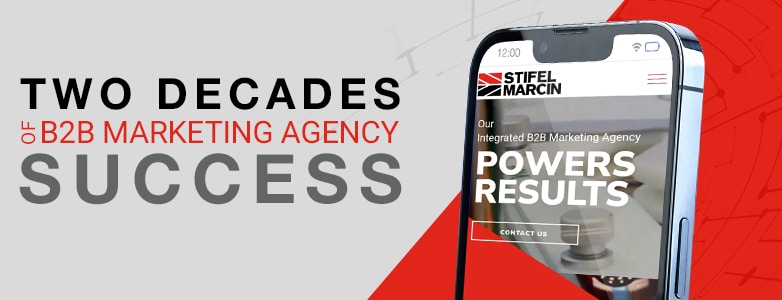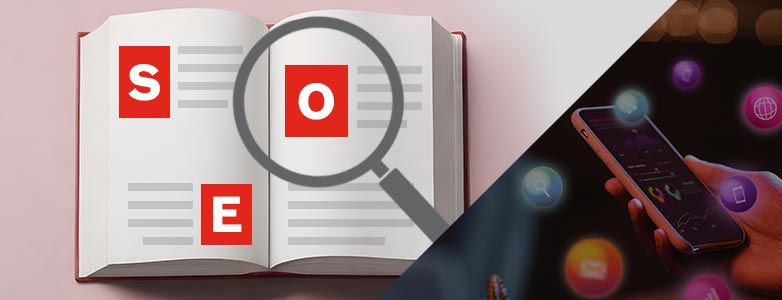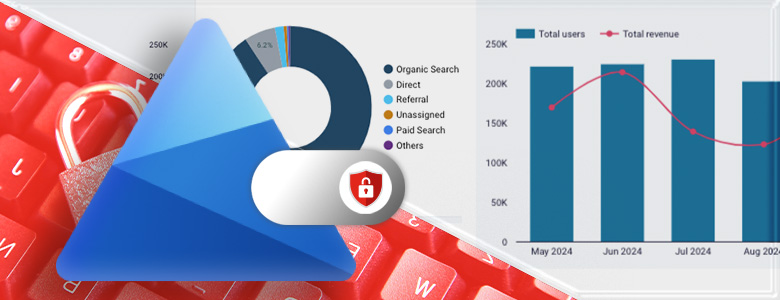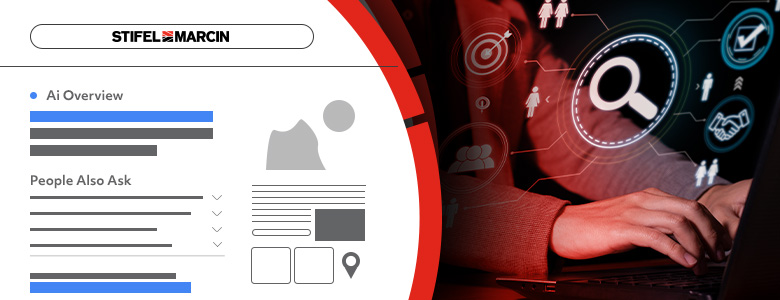Search engine optimization, more commonly known as SEO, has evolved rapidly, incorporating AI and complex algorithms. With updates constantly reshaping the landscape, it can be challenging for B2B marketers to keep up with SEO terminology.
To help you stay informed and navigate its complexities, the expert team at Stifel Marcin has created a comprehensive SEO glossary of terms. Whether you are a seasoned pro or a beginner in SEO, we hope this resource becomes your go-to guide for understanding SEO vocabulary and concepts that power successful campaigns.
SEO Terminology A-Z
If you need to brush up on your SEO vocabulary, our SEO glossary of terms provides clear and concise definitions for common terms. If you have questions about search engine optimization, reach out to our team. With years of experience and a deep understanding of search engine algorithms, we can help you unlock the full potential of your online presence.
A
• Accelerated Mobile Pages (AMP): AMP is a simplified form of HTML aimed at speeding up the browsing experience for mobile users.
• AI Content Optimization (AIO): The process of tailoring your digital content to ensure it is accurately understood, indexed, and utilized by AI-powered platforms.
• Algorithm: A complex set of rules used by search engines to rank websites in the search results.
• Alt Text (Alternative Text): Descriptive text for images to help search engines understand the content of images.
• Answer Engine Optimization (AEO): The process of optimizing your online content to provide clear and accurate answers to specific questions users ask in search engines.
• Application Programming Interface (API): An API enables the development of applications by providing access to the functions or data of another service, such as an operating system or application.
• Anchor Text: This refers to the clickable text used to link to other pages.
• Artificial Intelligence: The simulation of human intelligence by machines. In SEO, AI analyzes data, predicts trends, and researches improving search engine algorithms and enhancing search results with no-click insights.
• Auto-Generated Content: Content produced automatically by programs rather than written by humans.
B
• Backlink: A link from one website to another, which can improve a site’s authority and ranking.
• Bing Webmaster Tools: A free service provided by Microsoft that assists in monitoring and troubleshooting your website’s visibility in Bing’s search results.
• Black Hat: These are search engine optimization techniques that breach Google’s quality standards. Black hat techniques can result in your website being penalized.
• Bots: Also called “crawlers” or “spiders,” these are programs that browse the Internet to locate content.
• Bounce Rate: The percentage of visitors who leave a site after viewing only one page.
• Breadcrumb Navigation: Internal links that provide users and search engines with a clear path to navigate through your website.
• Broken Link: A hyperlink on a webpage that leads to a non-existent or “dead” resource, which can be either internal or external. This is sometimes indicated with a “404 Page Not Found” error message.
C
• Cached Page: A version of a webpage that Google saves on its servers during its most recent visit.
• Canonical Tag: The (rel=”canonical”) HTML code snippet specifies the primary version of duplicate, near duplicate and similar pages.
• Canonical URL: The preferred URL for a page, used to avoid duplicate content issues.
• Click-Through Rate (CTR): The ratio of users who click on a link to the number of total users who view a page or ad.
• Content Management System (CMS): Software used to create and manage digital content.
• Content Marketing: Creating valuable content to attract and retain an audience.
• Conversion Rate Optimization (CRO): Improving the percentage of website visitors who complete a desired action.
• Core Web Vitals: Metrics that are part of Google’s Page Experience signals, used to evaluate user experience.
• Crawlability: The capability of a search engine to access content on a webpage.
• Crawler: An internet program designed to systematically browse the internet, primarily used by search engines to discover, process, and index pages for search results.
• Customer Journey: A detailed mapping of the steps a consumer takes from their initial awareness of a brand to purchasing a product or service, and their experiences thereafter.
D
• Dofollow Link: A link that passes on PageRank, often referred to as a “followed” link.
• Domain Authority (DA): A metric developed by Moz that predicts how well a website will rank on search engines.
• Duplicate Content: Content that appears in more than one place on the internet, which can harm SEO performance.
E
• E-A-T: Stands for Expertise, Authoritativeness, and Trustworthiness, factors used by Google to evaluate the quality of content.
• Entry Page: The initial page a visitor lands on when they visit your website.
• Evergreen Content: Content that remains relevant and does not become outdated.
• External Link: A link from your website to a different website.
F
• Featured Snippet: A summary of an answer to a user’s query, which is displayed on top of Google’s search results.
• Footer Link: Links that are placed in the footer section of a webpage.
G
• Google Analytics: A web-based service offered by Google that measures website traffic and performance based on an analysis of data and statistics.
• Googlebot: Web crawler that drives Google’s search engine.
• Google Business Profile: A free business listing provided by Google that appears in maps and web search results and allows a company to claim/create a profile, and update the profile with information including hours, links, and photos.
• Google Consent Mode: A feature that allows websites to adjust how Google tags behave based on user consent. It enables websites to respect users’ privacy choices regarding cookies while still measuring key metrics and optimizing performance.
• Google Search Console: A web service by Google which allows webmasters to check indexing status and optimize visibility of their websites.
H
• Heading Tags (H1-H6): HTML tags used to define headings on a webpage.
• Hreflang: An HTML attribute used to inform Google about different language and regional versions of a webpage.
• HTTPS: A secure version of HTTP that encrypts communications between your browser and the server, working to safeguard them from interception and tampering by attackers.
• Hypertext Markup Language (HTML): The standard markup language for documents designed to be displayed in a web browser.
I
• Inbound Link: A hyperlink from another website that points to your site.
• Index: A database of web pages created by search engines.
• Indexability: The capacity of a search engine to analyze and store a webpage in its database.
• Informational Query: A query made by someone seeking information rather than products.
• Internal Link: A hyperlink that points to another page on the same website.
J
• JavaScript SEO: A subset of technical SEO focused on optimizing JavaScript-heavy websites to be more search-friendly.
K
• Keyword: A word or phrase that users enter search engines, which SEO professionals target to rank in search results.
• Keyword Cannibalization: This occurs when a single website unintentionally targets the same keyword in multiple posts or pages.
• Keyword Clustering: An SEO practice that involves grouping similar and relevant keywords into collections.
• Keyword Density: The percentage of times a keyword appears on a page compared to the total number of words on the page.
• Keyword Difficulty: A metric provided by various SEO tools to estimate how hard it is to rank for a specific keyword.
• Keyword Ranking: The position of a website in the organic search results for a particular keyword.
• Keyword Stuffing: The practice of excessively repeating the same keywords or phrases in your content to try to manipulate search rankings.
L
• Landing Page: The page a user enters a website on after clicking a link from a search engine.
• Latent Semantic Indexing (LSI): A technique used by search engines to understand the context and synonyms of keywords.
• Local SEO: The process of optimizing your online presence to appear and rank higher in relevant search results within a localized geography.
• Long-Tail Keyword: A low-volume search query focused on a specific topic. Read more in our article “The Importance of Long-Tail SEO.”
M
• Meta Description: A brief description of a page’s content that appears in search engine results.
• Meta Tags: Snippets of code that provide search engines with essential information about your webpage.
• Meta Title: The title of a webpage that appears in search engine results.
• Mobile Optimization: Ensuring a website performs well on mobile devices, like phones and tablets.
N
• Negative SEO: When a competitor employs unethical tactics to try to undermine the rankings of a rival website or webpage.
• NoFollow: A value that can be assigned to the rel attribute of an HTML link to instruct search engines that the hyperlink should not influence the ranking of the link’s target.
O
• Off-Page SEO: Activities performed outside the website to improve its rankings, such as link building and social media marketing.
• On-Page SEO: Techniques used to optimize individual web pages to rank higher, including keyword optimization, meta tags, and content quality.
• Organic Traffic: Website visitors who come through unpaid search engine results.
• Outbound Link: A link that points to a page on another website.
P
• Page Authority (PA): Like Domain Authority, but specific to individual pages.
• Page Rank: A formula that judges the value of a page by looking at the quantity and quality of other pages that link to it.
• Page Speed: The time it takes for a web page to load completely.
Q
• Query: The words and phrases that users type into a search engine.
R
• Rich Snippet: Enhanced search results that show additional information like reviews, ratings, or event details.
• Robots.txt: A file that instructs search engine robots which pages to crawl and which to ignore.
S
• Schema Markup: Code added to a website to help search engines return more informative results for users.
• Search Engine Optimization (SEO): The process of optimizing a website to improve its visibility in search engine results pages (SERPs). Learn more about Stifel Marcin’s expert B2B SEO services.
• Search Engine Optimization Audit: A comprehensive evaluation of a website’s SEO performance. Read more about the benefits of an SEO audit from our experts.
• Search Engine Results Page (SERP): The page displayed by a search engine in response to a user’s search query.
• Search Volume: The total number of searches for a specific keyword or phrase within a given period, typically a month. High search volume indicates a significant number of people are looking for information related to that keyword.
• Short-Tail Keyword: A broad, general search term that typically consists of one to three words. These phrases have high search volume but also often a high competition due to their general nature.
• Sitelinks: Hyperlinks to other pages or sections within a page that appear below certain Google search results.
• Sitemap: A file that lists all the pages of a website, helping search engines understand its structure.
T
• Title Tag: An HTML element that specifies the title of a web page.
• Technical SEO: The process of optimizing a website’s technical structure, setup and configuration to make it more accessible to search engines, including factors such as site speed, mobile-friendliness, indexing, crawling, and site architecture.
U
• Uniform Resource Locator (URL): The address of a web page. For instance, Stifel Marcin’s URL is https://stifel-marcin.com.
• URL Slug: A URL Slug is the part of the URL that follows the slash (“/”) after the domain name or subfolder.
• User Experience (UX): The overall experience of a user interacting with a website, which can impact SEO.
V
• Viral Content: Content that becomes very popular very quickly through social sharing.
• Voice Search: A technology that allows users to perform searches using voice commands.
W
• Web Crawler: A bot that systematically browses the web to index web pages for search engines.
• Website Authority: A metric provided by SEO tools that gauges the relative strength of a website.
• White Hat SEO: SEO practices that comply with best practice search engine guidelines.
X
• XML Sitemap: A file that lists a website’s important pages to help search engines crawl and index the site effectively.
• X-Robots-Tag: An HTTP header sent from a web server that contains the directives for web crawlers such as Googlebot.
Y
• Yield: The return on investment from SEO activities, measured in terms of increased traffic, leads, or sales.
Z
• Zero-Click Searches: Search results that provide the answer directly on the SERP without requiring the user to click on a link.
Leverage Our B2B SEO Expertise to Power Up Your Results
Understanding SEO terminology and fundamentals is crucial for any business looking to thrive in the digital landscape. While SEO is complex, our B2B digital marketing team is here to simply the process. With our expertise in keyword research, content optimization, and technical SEO, we can help your business achieve top search engine rankings and drive sustainable growth.
Reference our SEO glossary of terms often and contact us today to begin your SEO journey to success. As a top B2B SEO agency, we specialize in solutions that deliver results. Our strategic approach attracts the right audience, builds brand authority and drives sales growth.

Stifel Marcin – The B2B Marketing Agency
Unlike many advertising and marketing agencies, B2B isn’t just something that we do, it’s all we do. We’ll work to help your brand achieve its goals through the strategic combination of creativity, communication and technology. Our focused client intake processes give us the ability to thoroughly understand your business, products and objectives, working to identify the competitive advantages and opportunities that will grow awareness, leads and sales. We develop innovative marketing plans with strategic, data-driven processes, presenting complex ideas and compelling messages that position your business ahead of the competition.
As your cooperative partner, our integrated B2B marketing agency is dedicated to your success. If you have questions about this SEO glossary of terms or search engine optimization strategies, let’s talk.




